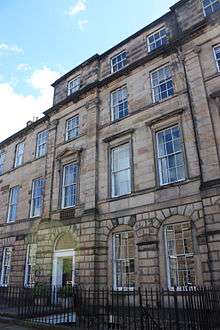John Shank More


John Shank More (sometimes written as John Schank More) LL.D., F.R.S.E. FSA (1784–1861) was George Joseph Bell’s successor at the University of Edinburgh in the chair of Scots Law, which he held from 1843 to 1861. He was involved in the anti-slavery movement [1] and was Vice-President of the Royal Scottish Society of Arts.[2]
Life
More was born in North Shields in County Durham, the son of Rev. George More, for some time Presbyterian minister at South Shields.[3]
He was called to the Bar in 1806.[4] He married Mary Gillespie (d.1849) in 1811.
He was less famous than Hume and Bell, but none the less edited Erskine’s Principles and Stair’s Institutions. He was considered "a suitably learned man who inspired some affection in his students despite bbbthe dullness of his lecturing style".[5]
He was involved in the sudden departure of Karl Pearson's father from Edinburgh University.
In 1820 he was elected a Fellow of the Royal Society of Edinburgh. His proposers were Thomas Thomson, Sir David Brewster and James Bonar.[6]
In the 1830s he is listed as living at 19 Great King Street, a prestigious Georgian townhouse in Edinburgh's Second New Town.[7]
He was President of the Royal Scottish Society of the Arts 1844-45.[8]
He died in Edinburgh and is buried in the churchyard of St John's Episcopal Churchyard at the west end of Princes Street.[9]
Description
He is described as follows:
".... dear old modest Professor More, who never looked at the class, but glanced up at the end of every utterance to the upper left-hand corner of the class room, said in most sober tone:“And so” (head up) “as the sun can never set on the British Dominions” (head up) “so that sun can never rise upon a British slave.”
The worthy gentleman blushed as he looked for the last time at the corner, when for once the room resounded with a round of applause, possibly ironical to some extent, but kindly as well. There is one story connected with his name which may bear repetition.
A junior counsel had been asked for his opinion on the memorial of a client. He wrote below it:
“Your case does not seem to me to have a leg to stand upon. Perhaps it would be as well to take in the assistance of one Shank More.”
It is also told of him that his good nature led him on the occasion of an examination, when in answer to his question the student had said, “Yes” firmly, he gently responded: “Right, but rather ‘no’.”
,[10] p. 234
References
- ↑ Harriet Beecher Stowe (2004-11-01). "Sunny Memories of Foreign Lands". Project Gutenberg. Retrieved 2014-03-13.
- ↑ Robert Jameson (1843). The Edinburgh New Philosophical Journal: Exhibiting a View of the Progressive. 35. Retrieved 2014-03-13.
- ↑ http://www.royalsoced.org.uk/cms/files/fellows/biographical_index/fells_indexp2.pdf
- ↑ Douglas, W. S. (1882). Modern Athenians: A Series of Original Portraits of Memorable Citizens of Edinburgh. A. and C. Black.
- ↑ Cairns, J.W., & MacQueen, H.L. (2002) Learning and the Law: A Short History of the Edinburgh Law School. School of Law, University of Edinburgh. http://www.law.ed.ac.uk/__data/assets/pdf_file/0008/117890/History_of_Law_booklet_web.pdf
- ↑ BIOGRAPHICAL INDEX OF FORMER FELLOWS OF THE ROYAL SOCIETY OF EDINBURGH 1783 – 2002 (PDF). The Royal Society of Edinburgh. July 2006. ISBN 0 902 198 84 X.
- ↑ http://digital.nls.uk/directories/browse/pageturner.cfm?id=83401227&mode=transcription
- ↑ http://www.rssa.org.uk/history/past-presidents.shtml
- ↑ http://www.royalsoced.org.uk/cms/files/fellows/biographical_index/fells_indexp2.pdf
- ↑ Macdonald, J. H. A. (1915). Life jottings of an old Edinburgh citizen. T. N. Foulis.
Bibliography
- Armour, H., & Wigham, J. (1851). To John Shank More, Professor of the Law of Scotland in the University of Edinburgh. H. Armour.